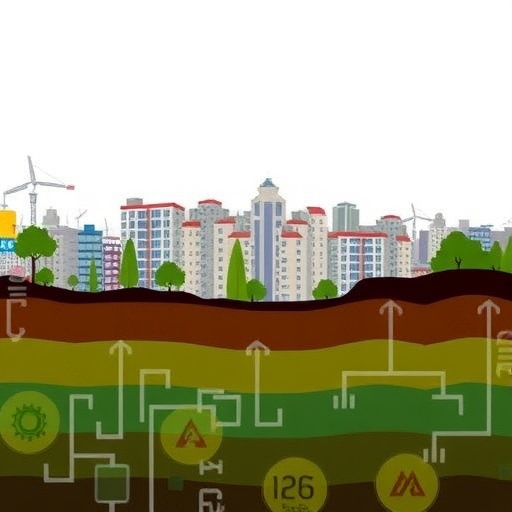Urban Soil Pollution in Türkiye: Unveiling the Dark Side of Urban Expansion
Urbanization has reshaped landscapes across the globe, bringing both opportunities and pressing challenges. In Türkiye, rapid urban development has led to environmental transformations that are increasingly coming under scrutiny. A recent review, spearheaded by Çayır et al., highlights an alarming aspect of this transformation: urban soil pollution. As cityscapes morph and expand, the underlying soils, often overlooked, become repositories for a cocktail of potentially toxic elements, polycyclic aromatic hydrocarbons (PAHs), and microplastics. This study illuminates the multifaceted and concerning dynamics of soil quality in major Turkish cities, posing critical questions about public health and ecological integrity.
The study established a framework for understanding urban soil pollution, pointing to how soil can act as both a sink for pollutants and a source of problematics for urban dwellers. Soils are not just passive layers beneath our feet; they interact dynamically with air, water, and living organisms, making them critical to both urban ecosystems and human health. Contaminated soils can lead to the leaching of toxic substances into groundwater, affecting not only environmental quality but also human health directly through food systems and exposure pathways.
Researchers identified several potentially toxic elements (PTEs) of concern, including lead, arsenic, and cadmium, which are often found in urban soils due to industrial activities, vehicle emissions, and improper waste disposal. The cumulative consequences of these elements accumulate not just in soil but permeate the very air and water systems that urban populations depend upon. Such pollution raises questions about regulatory oversight and the implementation of more stringent environmental protection measures.
Alongside PTEs, the presence of polycyclic aromatic hydrocarbons (PAHs) in urban soils marks a significant environmental hazard. These organic compounds, resulting from incomplete combustion of organic material, are notorious for their mutagenic and carcinogenic properties. The urban environment serves as an incubator for these compounds, with common culprits including vehicular emissions, industrial discharges, and even residential heating methods. As their prevalence grows, so too does the need for effective management strategies to mitigate their impact on human health and local ecosystems.
Microplastics have emerged as another critical concern in urban soil studies. The infiltration of plastic particles into soil has escalated with the exponential increase in plastic use and poor waste management practices. These microplastics not only physically alter soil composition but also affect microbial communities, which are vital for nutrient cycling and overall soil health. The review by Çayır et al. highlighted a disconcerting trend: urban soils are becoming increasingly laden with these pervasive pollutants, reflecting broader environmental patterns globally.
Moreover, the review notes the disparities between urban regions within Türkiye, with larger cities like Istanbul and Ankara showing higher concentrations of pollutants compared to less populated areas. This urban-rural divide underscores the nuanced nature of pollution; while larger populations create greater emissions, smaller towns may lack the infrastructure for effective waste management, leading to localized environmental crises.
The findings also resonate with the broader climatological context, drawing attention to how climate change can exacerbate existing soil pollution problems. Increased rainfall and flooding can mobilize contaminants, spreading them over wider areas and threatening water quality. The researchers argued for a synergistic approach to urban planning, where environmental considerations are woven into the fabric of city management and development practices.
Interdisciplinary collaboration is vital to addressing the urban soil crisis. Environmental scientists, urban planners, policy makers, and public health experts must come together to forge cohesive strategies that target pollution at its source. The importance of public awareness cannot be understated; a well-informed citizenry can advocate for change and hold local governments accountable for environmental stewardship.
The review’s conclusions serve as a clarion call for robust policy interventions aimed at preserving urban soil health. Effective soil management strategies, pollution control regulations, and community engagement initiatives can significantly mitigate the current trajectory of urban soil degradation. Integrated management systems that incorporate green infrastructure, sustainable practices, and soil remediation technologies can pave the way for healthier urban environments.
Importantly, the study highlights the role of education in fostering a culture of environmental responsibility and sustainable practices. By investing in soil science education and promoting simple actions that can reduce pollution, stakeholders can create a more informed public that values and protects their local environment.
Finally, as cities in Türkiye stand on the cusp of further development, the insights offered by Çayır et al. not only chart a path for immediate action but also call for a reimagining of what urban landscapes can be. The benefits of investing in clean soil ecosystems extend beyond environmental health, promising better quality of life, increased biodiversity, and sustainable urban growth that harmonizes with nature.
As the world grapples with the implications of urbanization, Türkiye’s challenge and response to urban soil pollution serve as a microcosm of broader global environmental issues. It is imperative that the lessons drawn from this review propel urgently needed changes towards sustainable urban environments. The future of urban living undoubtedly hinges on our ability to manage our soil resources wisely, equipping cities to thrive in harmony with their natural surroundings.
Subject of Research: Urban soil pollution in Türkiye.
Article Title: Urban soil pollution in Türkiye: a review of potentially toxic elements, polycyclic aromatic hydrocarbons, and microplastics in major cities.
Article References: Çayır, G., Rouhani, A., Al Souki, K.S. et al. Urban soil pollution in Türkiye: a review of potentially toxic elements, polycyclic aromatic hydrocarbons, and microplastics in major cities. Environ Monit Assess 197, 1366 (2025). https://doi.org/10.1007/s10661-025-14834-5
Image Credits: AI Generated
DOI: https://doi.org/10.1007/s10661-025-14834-5
Keywords: Urbanization, soil pollution, potentially toxic elements, polycyclic aromatic hydrocarbons, microplastics, Türkiye, environmental health, sustainable urban development.




